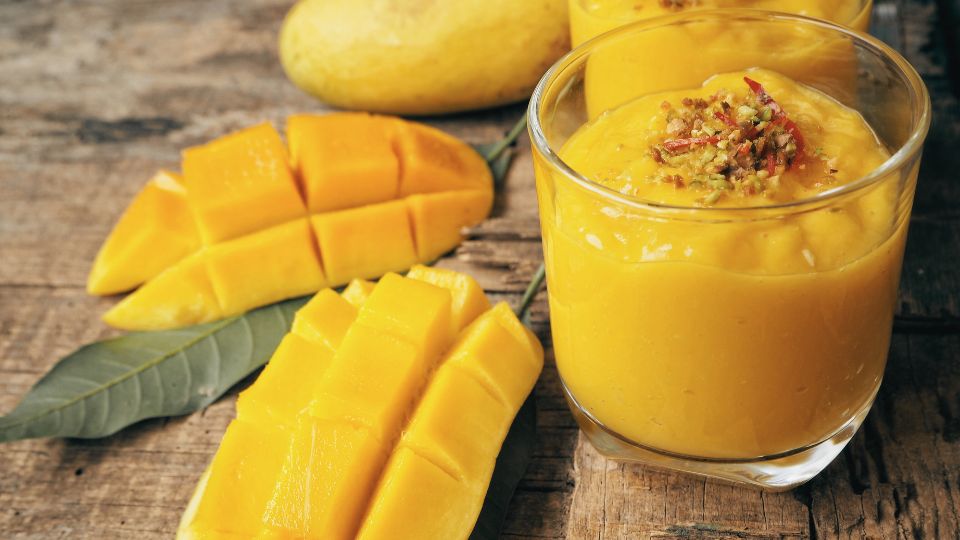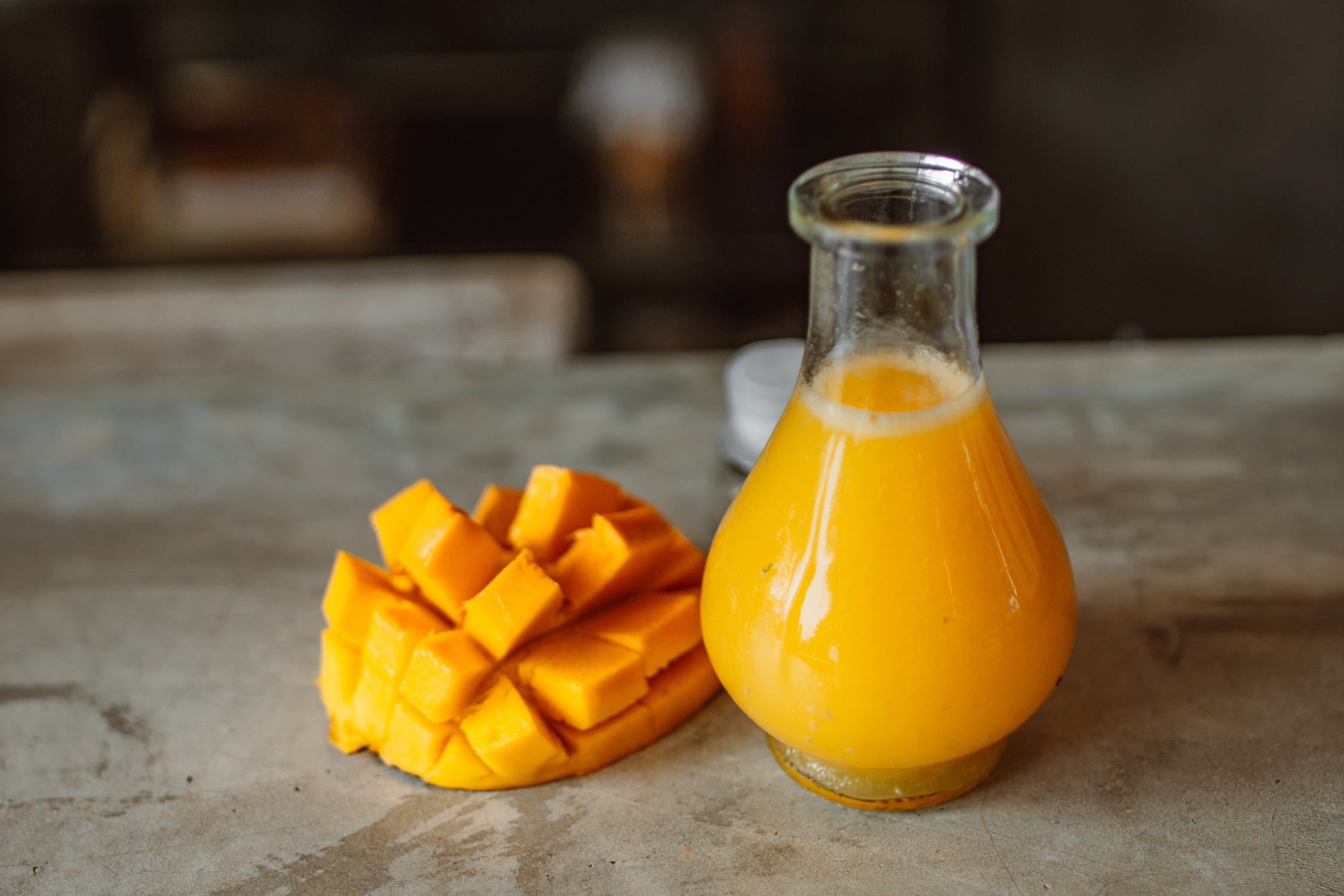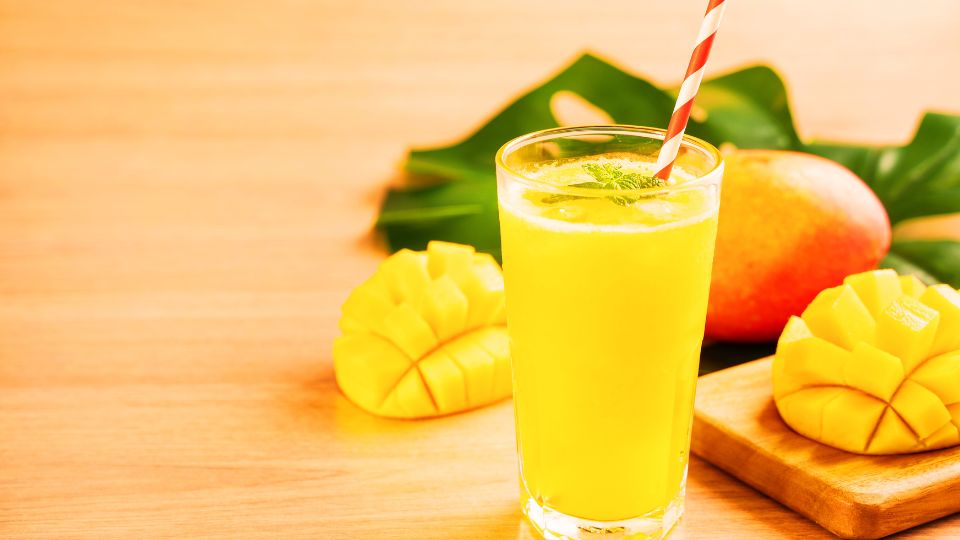Mangoes are a tropical fruit with a sweet and tangy flavor, making them a popular ingredient for juices and smoothies. Making mango juice at home is a simple and healthy way to enjoy the fruit’s benefits, and preserving it can ensure that you have a supply of delicious juice on hand.
In this article, we will discuss step-by-step instructions for making and preserving mango juice, as well as tips and precautions for best results.
Making Mango Juice
Mango juice is a delicious and refreshing drink that can be enjoyed year-round. Here are the steps to making your own homemade mango juice:
Choosing the right mangoes
When selecting mangoes for juice, it’s important to choose ripe mangoes that are soft to the touch and have a sweet aroma. Mangoes that are too firm or have a sour smell may not be fully ripe and may not yield as much juice. It’s recommended to choose mangoes that are specifically marketed as juicing mangoes, such as the Ataulfo or Honey mango varieties, which are known for their juicy and sweet pulp.
Here are some tips for choosing the right mangoes:
- Look for the right color: Mangoes come in various shades of green, yellow, and red. Depending on the variety, the color of ripe mangoes can differ. Some may have a greenish-yellow color, while others may have a deep orange-red color. Look for mangoes that have a uniform color and are free of any dark spots or bruises.
- Check for firmness: The ideal mango for juicing should be ripe but still firm to the touch. It should not be too soft, as that may indicate over-ripeness and a higher likelihood of spoilage.
- Smell the mango: Mangoes should have a sweet and fruity aroma when they are ripe. If the mango smells sour or unripe, it may not be the best choice for juicing.
- Consider the variety: Different varieties of mangoes have different levels of sweetness and flavors. Some of the most popular varieties for juicing include Ataulfo, Alphonso, and Tommy Atkins.
- Check the season: Mangoes are typically in season during the summer months. Check with your local grocery store or farmer’s market for the best time to purchase mangoes in your area.
Cleaning and preparing the mangoes
Before preparing the mangoes, wash them thoroughly with water to remove any dirt or debris. Then, remove the stem from the top of the mango and cut the mango into small pieces, discarding the pit and skin. Make sure to cut around the pit, as it is not edible and can be tough to remove after blending.
Extracting the mango pulp and juice
Place the mango pieces in a blender or food processor and blend until smooth. If the mixture is too thick, add a small amount of water to help with blending. Once blended, pour the mixture through a fine mesh strainer to remove any large pieces of pulp or fibers. You can also use a juicer to extract the juice from the mangoes.
Adding sweetener and other flavorings (optional)
If desired, you can add sweetener such as honey, agave syrup, or sugar to taste. Other flavorings such as lime juice or mint can also be added for an extra zing. Note that adding sweeteners will increase the calorie and sugar content of the juice. To keep the juice as healthy as possible, it’s recommended to consume it without any added sweeteners.
Preserving Mango Juice
Mango juice is a refreshing and healthy drink that is enjoyed by many. While fresh mango juice is the best, preserving it allows you to enjoy it all year round. Here is a guide on how to preserve mango juice.
Sterilizing containers and lids
The first step to preserving mango juice is to sterilize your containers and lids. This can be done by washing them with hot, soapy water and then boiling them for 10 minutes. Alternatively, you can run them through a dishwasher on a high-heat setting.
Filling containers with mango juice
Once your containers and lids are sterilized, fill them with mango juice. Be sure to leave some headspace at the top of the container to allow for expansion during freezing or canning.
Adding preservatives (optional)
Adding preservatives to your mango juice is optional but recommended. This can help prolong the shelf life of the juice and prevent spoilage. Common preservatives used for fruit juices include citric acid or ascorbic acid. Follow the instructions on the packaging for the correct amount to add to your juice.
Properly sealing containers
After adding preservatives (if desired), make sure to properly seal your containers. For canning, this may involve using a canning machine to seal the lids. For freezing, use containers that are freezer-safe and seal them tightly.
Storing mango juice
Proper storage is essential to preserving mango juice. Canned mango juice should be stored in a cool, dry place. Frozen mango juice can be stored in the freezer for up to 8-12 months. Thaw frozen juice in the refrigerator before use.
Methods of Preservation
If you have more mango juice than you can consume in one sitting, you may be wondering how to preserve it for later use. Let’s discuss about the three common methods of preservation: refrigeration, freezing, and canning.
Refrigeration
Refrigeration is the easiest and most common method of preserving mango juice. Here’s how to do it:
- First, make sure your mango juice is in an airtight container. This will prevent the juice from absorbing any odors from your refrigerator.
- Pour the mango juice into the container, leaving about an inch of space at the top.
- Seal the container tightly and store it in the refrigerator.
- Mango juice can be stored in the refrigerator for up to five days.
Freezing
Freezing is another easy way to preserve mango juice. Here’s how to do it:
- Pour the mango juice into a freezer-safe container, leaving some space at the top. This will allow the juice to expand as it freezes.
- Seal the container tightly and label it with the date.
- Store the container in the freezer.
- Mango juice can be stored in the freezer for up to six months.
Canning
Canning is a more involved process that requires specialized equipment. However, it is a great option if you want to preserve large amounts of mango juice for an extended period of time. Here’s how to can mango juice:
- Sterilize your canning jars and lids according to the manufacturer’s instructions.
- Heat the mango juice in a large pot until it reaches a rolling boil.
- Pour the hot mango juice into the sterilized canning jars, leaving about 1/2 inch of space at the top.
- Wipe the rims of the jars with a clean cloth and place the lids on top.
- Screw the bands onto the jars, but do not over-tighten.
- Place the jars in a canning pot and cover them with water. Bring the water to a boil and process the jars for the recommended time based on your altitude and jar size.
- Once the processing time is complete, carefully remove the jars from the pot and allow them to cool on a towel.
- Check the seals on the jars to ensure they are tight. Any jars that did not seal properly should be refrigerated and consumed within a few days.
- Canned mango juice can be stored in a cool, dark place for up to one year.
No matter which method you choose, you should properly label and date your mango juice. This will help you keep track of when the juice was made and ensure that it is safe to consume.
Tips and Tricks for Best Results
Choose the right containers
When preserving mango juice, it is important to choose the right containers. Glass jars or bottles with tight-fitting lids are a good option. Plastic containers can also be used, but make sure they are made of food-grade plastic and are BPA-free. Avoid using metal containers as they can react with the acid in the juice and affect the flavor.
Use high-quality ingredients
Using high-quality ingredients is essential when making and preserving mango juice. Choose ripe and fresh mangoes, and make sure they are free of bruises or blemishes. Use clean and sanitized utensils, and wash your hands before handling the mangoes.
Follow instructions carefully
When preserving mango juice, it is important to follow instructions carefully. This includes sterilizing containers and lids, filling containers with mango juice, adding preservatives (if desired), and properly sealing containers. Be sure to read the instructions on your specific preservation method carefully and follow them closely.
Store mango juice properly
Proper storage is key to keeping your mango juice fresh and safe to drink. Refrigerate your juice immediately after making it, and consume it within 3-5 days. If you want to store it for longer, you can freeze it or can it. When freezing, make sure to leave some headspace in the container as the juice will expand when frozen. When canning, make sure to follow proper canning procedures and use a pressure canner if necessary.
Precautions and Considerations
Mango juice, like any other food, is susceptible to spoilage and contamination by harmful bacteria. This is especially true if the juice is not handled or stored properly. Symptoms of foodborne illness can range from mild digestive discomfort to more serious conditions such as vomiting and diarrhea.
To reduce the risk of foodborne illness, it is important to use clean equipment when making and storing mango juice. This includes washing all utensils, cutting boards, and containers with soap and hot water before use. Additionally, follow proper food safety guidelines such as washing hands frequently and keeping raw ingredients separate from ready-to-eat foods.
If you notice any signs of spoilage in your mango juice, such as a sour smell, mold growth, or an off-taste, you should discard the juice immediately. Consuming spoiled mango juice can cause foodborne illness and other health complications.
Conclusion
Mango juice is a tasty and nutritious beverage that can be made easily at home. With the right equipment and ingredients, you can make a batch of mango juice and preserve it for later use. Whether you choose to refrigerate, freeze, or can your juice, it’s important to follow proper food safety guidelines and use high-quality ingredients for best results. With these tips and tricks, you can enjoy the delicious taste and health benefits of mango juice all year round.







